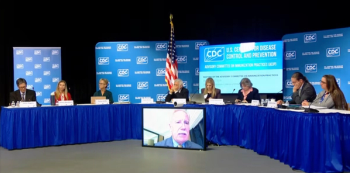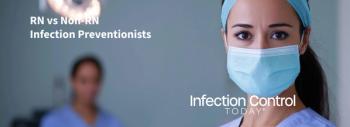
At IDWeek, Dr Tom Frieden Urges a Simple Formula to Tackle Outbreaks and Drug Resistance: “See. Believe. Create.”
At IDWeek in Atlanta, former CDC director Tom Frieden unveiled a crisp playbook for infection prevention—“See. Believe. Create.”—arguing it can help hospitals spot outbreaks sooner, reverse drug resistance, and drive HAIs toward zero. He paired the message with a 7-1-7 target: 7 days to find an outbreak, 1 to report, 7 to control.
At IDWeek in Atlanta, former CDC director Tom Frieden unveiled a crisp playbook for infection prevention—“See. Believe. Create.”—arguing it can help hospitals spot outbreaks sooner, reverse drug resistance, and drive HAIs toward zero. He paired the message with a 7-1-7 target: 7 days to find an outbreak, 1 to report, 7 to control.
Amid the bustle of IDWeek in Atlanta, Georgia, held from October 19 to 22, 2025, former CDC director Tom Frieden, MD, MPH, now president and CEO of Resolve to Save Lives, laid out a crisp playbook for infectious-disease professionals: a 3-step formula he says can prevent outbreaks, reverse drug resistance, and save “millions of lives.”
In a conversation with Infection Control Today, before the conference, Frieden previewed the themes of his new book,
Step 1: See the Invisible
Frieden argues that public health’s “superpower” is the ability to detect what others miss and then turn those insights into action. “First, see the invisible,” he said. “See not just the numbers and drug resistance or things like the genomic epidemiology to understand the spread; see also the path to progress and see whether our programs are succeeding or failing. This is public health’s superpower.”
That vision, he added, requires nimble use of surveillance data, feedback loops that measure performance at the bedside, and the willingness to change tactics when results lag. It also means recognizing that many infections we accept as inevitable are, in fact, preventable.
Step 2: Believe Change Is Possible
The second step is psychological but no less essential. “Believe that we can change it. Believe the impossible,” Frieden said. “All too often, we assume that things are inevitable, when in fact, we can change them.”
That mindset shift is especially important for health care-associated infections (HAIs). “I’m confident that in 20, 30, 40 years, we will look back on the burden of hospital-associated infections in the US today and think, ‘How could they have let that happen?’” he said. “This is not a criticism of any 1 individual. We have great tools to have a better understanding to see the invisible, how infections are spreading in hospitals and other healthcare facilities.”
Step 3: Create a Disciplined, Organized Response
The third step turns belief into execution. “Work together to create a healthier future with organized, simple, well-communicated strategies that overcome the barriers to progress,” Frieden said. He pointed to practical elements that high-reliability organizations embrace checklists, empowered infection-prevention units that track and reduce infections, and clear communication with patients, frontline staff, and leadership. “Systematically overcoming the barriers…including inertia…is the path to lower infection rates,” he added.
A Lineage That Began in 1662
Frieden’s formula is anchored in history as much as modern analytics. “One thing that surprised me was that public health surveillance actually started in 1662, with a cloth merchant named John Grant,” he said, describing what is widely regarded as the first epidemiologic analysis of community health. Grant “described emerging diseases such as rickets” and even the economic implications of epidemics. Plague, Grant showed, sometimes killed most of a community, but other fevers were “more economically disruptive, because they caused so much illness that they were, as he put it, ‘scarce hands enough to bring in the harvest.’” For Frieden, the lesson is timeless: measure what matters, then act.
From Multidrug-Resistant Tuberculosis to Carbapenem-Resistant Enterobacterales: Lessons Learned
Frieden’s stance is shaped by hard-won experience. “Over the past decades, I’ve worked on issues like multidrug-resistant tuberculosis, Ebola, the spread of Carbapenem-resistant Enterobacterales and other resistant organisms,” he said. The through line: when leaders see clearly, believe improvement is possible, and create a disciplined plan, progress follows.
The 7-1-7 Target: “Find a Problem, Fix a Problem”
Frieden’s company, Resolve to Save Lives, has translated that mindset into a measurable target for outbreak detection and control. “The policy is 7-1-7—7 days to find every outbreak after it emerges, 1 day to report it to public health, and 7 days to have all essential control measures in place,” Frieden explained. “What we’re finding is that the 7-1-7 approach allows a ‘find a problem, fix a problem’ kind of worldview. Every single outbreak is an opportunity for continuous improvement with a simple yes/no—was it met or not? If not, not a blame to anyone—identify the bottlenecks and enablers and use that data to improve performance.”
What This Means for IPC Leaders
For infection preventionists, epidemiologists, environmental services leaders, sterile processing professionals, and infectious disease clinicians, Frieden’s message is both a challenge and a charge:
- Make the invisible visible. Use surveillance, point-prevalence checks, and genomic/epidemiologic tools to map how infections move through your facility.
- Set bold but concrete goals. Treat HAIs as unacceptable, and back that position with transparent metrics tied to accountability at every level.
- Organize for reliability. Standardize with checklists, empower your infection prevention and control unit to drive change, and ensure leadership communication keeps momentum high.
- Practice 7-1-7. Build the reflexes to detect, report, and control quickly—and debrief every event to get faster next time.
Frieden summed up the ethos in one sentence: “What we need to be doing in health care and public health is using data to improve performance, and that’s what ‘see, believe, create’ is all about—see the invisible trends, strengthen belief that we can change them, and then work together systematically to create a healthier future.”
For a field accustomed to complexity, the appeal is obvious: a simple, memorable framework grounded in evidence and experience that turns vision into action.
Newsletter
Stay prepared and protected with Infection Control Today's newsletter, delivering essential updates, best practices, and expert insights for infection preventionists.






